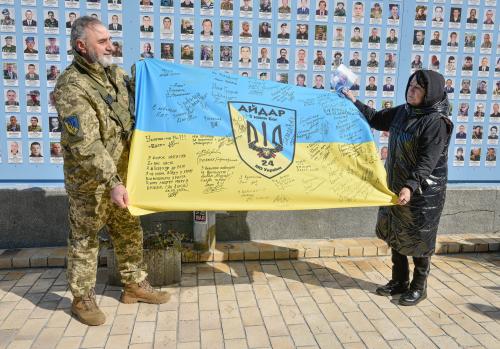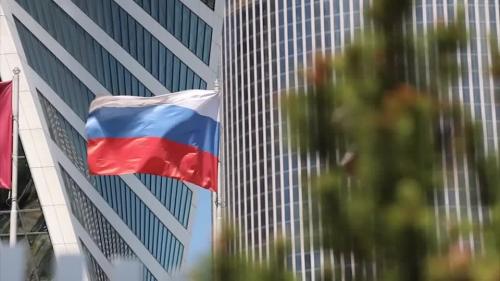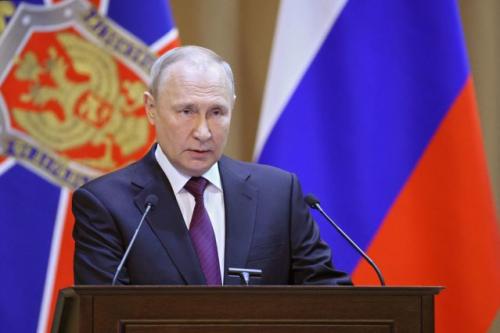Since it was seized by Russian military forces a year ago, the Zaporizhzhia Nuclear Power Plant in eastern Ukraine has lost external power six times. Following the latest outage, the director general of the International Atomic Energy Agency (IAEA), Rafael Mariano Grossi, issued an emotional call to action, warning that it is only a matter of time before a disaster occurs. Given the fact that Zaporizhzhia sits on the frontline of a war zone, what can be done to prevent catastrophe?
On September 30, 2022, Russian President Vladimir Putin claimed Moscow had annexed the Zaporizhzhia region. So far, power outages have been handled by sourcing electricity from a coal-fired thermal power station and diesel generators. But if the final remaining power line from the national grid is damaged, on-site diesel generators cannot cool fuel in each of the plant’s six reactors in the long term. Should these backup generators fail, the subsequent loss of coolant could trigger a fuel meltdown. And as power outages, shelling, and even kidnappings of Ukrainian plant operators continue, that risk is escalating.
Zaporizhzhia is different from prior nuclear power plant crises for two main reasons. First, Russia’s weaponization of Zaporizhzhia is entirely novel. Never has a nuclear power plant been used as a nuclear shield (manipulated to protect Russian troops and military hardware), and never has a country threatened to co-opt a plant by siphoning power back into its own grid. Second, this new situation is occurring against the backdrop of an ongoing dispute over the plant’s ownership, bringing up issues over which country is responsible for its safety. Grossi likely knows a coordinated international response isn’t imminent. Prior power plant crises reveal that solutions are slow to arrive — even during peacetime. As such, he is appealing directly to Ukraine and Russia, calling on the two countries to agree to a demarcated demilitarized zone around all power plants, including Zaporizhzhia, with limited success.
Previous Power Plant Crises
Though the current crisis is unique, nuclear power plant crises are only rare — not unprecedented. In 1979, a power surge caused radioactive material to leak at Three Mile Island in the United States. Following this crisis, the U.S. nuclear industry created the Institute of Nuclear Power Operations, tasked with fostering safety and reliability in nuclear power plant operations.
In 1986, another sudden power surge caused a severe radiation leak at the Chernobyl nuclear power plant in Ukraine (then part of the Soviet Union). Although the first four years post-crisis were confined to responses at the national level, Chernobyl ultimately resulted in the creation of multiple international safety conventions, two Codes of Conduct, and the IAEA’s Safety Standards.
In 2011, an earthquake-triggered tsunami interrupted the power supply to Japan’s Fukushima nuclear power plant. Three reactors melted down, leading to a series of explosions and yet another radiation leak. Immediately following the crisis, the IAEA’s Incident and Emergency Care Centre sent experts and launched radiation protection and data collection efforts. Three months later, the IAEA hosted a Ministerial Conference on Nuclear Safety, leading to the IAEA Action Plan on Nuclear Safety.
In the aftermath of Fukushima, the European Union brought Ukraine into a program to assess and improve reactor safety. Ensuing efforts directly affected Zaporizhzhia: Western governments and industry accelerated upgrades to the plant’s reactors, attempting to prevent similar natural disasters from destabilizing the infrastructure.
Unsurprisingly, the nuclear reactor crisis-response pattern and recent IAEA action plan for Zaporizhzhia offer no guidance for how to deal with nuclear facilities that are located in or near a battlefield, even though nuclear reactors have been caught up in conflicts before. In 1991, the Slovenian nuclear power plant, Krsko, was threatened by the Yugoslav Air Force. Operators determined that putting the plant into cold shutdown mode was the best way to minimize risk to the public. In this mode, experts surmised Krsko could sustain the loss of all off-site power and cooling long enough to implement other emergency responses.
In 1981, Israel conducted an airstrike on Iraq’s Osirak nuclear research reactor, which was linked to a research facility Israel suspected of developing nuclear weapons. Ten years later during the first Gulf War, allied bombers attacked two Iraqi nuclear research reactors, one of which was fully operational and had built up a radioactive inventory. Although there were no significant radiological consequences from either attack, in both cases, the facilities were safeguarded by the IAEA — demonstrating that compliance with the IAEA’s rules offers no protection against hostile actions during combat operations.
While global governance initiatives have improved the safety of nuclear power plants, these solutions are first and foremost a response to genuine accidents. And in cases where nuclear power plants were wrapped up in conflict, little was done by multilateral institutions to protect the facilities during wartime or prevent their use to shield troops and military equipment. Any other efforts at international regulations for nuclear power plants concerned the prospect of their use for nuclear terrorism. The current crisis is none of these.
Whose Responsibility?
Zaporizhzhia remains in danger in part because of its disputed ownership — a byproduct of the war. According to the United Nations, “nuclear safety is the responsibility of every nation that utilizes nuclear technology.” Since its occupation of the plant on March 5, 2022, Moscow has designated it as Russia’s “federal property,” created a state-run enterprise to oversee operations, and funded the plant’s management with a meager 500,000 rubles (about $6,500). But while Russian forces control the plant on territory that Moscow allegedly has annexed, Kyiv maintains that the plant and territory are Ukrainian, a position supported by virtually the entire world. This power struggle has raised questions about who is responsible for maintaining the plant’s safety and security.
The IAEA has been able to conduct intermittent inspections of Zaporizhzhia, but inspections — which are intended to collect information upon which safety recommendations can be made — and precautionary measures can only do so much against an unpredictable accident.
In previous crises like Fukushima, disaster was ultimately mitigated not necessarily through preventative policies, but through an emergency response system refined by historical examples like Chernobyl. Zaporizhzhia benefits from this history, having received structural and system-based reinforcements as a result of prior crises. As the threat of shelling continues, these reinforcements are providing added durability. Although the Zaporizhzhia crisis might be the first of its kind, it draws on a legacy of equally frightening instances that make a path forward possible, if not immediate.
Mark Hibbs has suggested that the safest option for the plant is to shut down all reactors, depressurize circuits, and remove fuel until the war is over. Zaporizhzhia could also be placed into cold shutdown mode indefinitely, as was done for Krsko.
Yet neither solution speaks to the motivations that Russia and Ukraine have for keeping the plant operational. Both have a reason to engage in shelling, just as both have an incentive to regain control and use the plant’s power for themselves. This, combined with the ongoing conflict for control over the plant, means that the Ukrainian-Russian cooperation required for managing risks is elusive.
As it stands, Zaporizhzhia was placed in a cold shutdown in September 2022. Operators have since restarted two reactors in hot shutdown mode, producing low levels of power to keep the plant operational. Perhaps this is why the IAEA has proposed a “protection zone” for Zaporizhzhia, in which both Ukraine and Russia would agree to refrain from firing at the plant, and heavy weapons would be removed from the area. Grossi correctly recognizes that an agreement of this nature must come from both countries and that their cooperation is essential to move toward any measure of stability.
Yet the Zaporizhzhia crisis cannot be categorized into a binary in which one side seeks to threaten or destroy another state’s power plant during wartime. Nor can previous examples of nuclear accidents fully apply to a situation in which the potential for an accident is entirely human-made. Instead, Zaporizhzhia currently sits between two warring parties who disagree on who should control it. Moreover, the global governance system, which requires a baseline level of cooperation if it has any hope of devising a new system to protect the security and safe operation of a nuclear power plant, is ill-suited to resolving the situation. As long as the war persists and Ukraine and Russia continue to jockey for control, disaster unfortunately looms large on the horizon.
The Zaporizhzhia crisis has highlighted the lack of international regulations governing nuclear power plants in wartime. Typically, international regulatory responses to nuclear power plant crises have taken time — time we don’t currently have. Future regulations must address not only the reality that nuclear power plants can be targeted in war, but that this targeting might involve hostage-style exploitation. They must also simultaneously offer parameters through which to establish ownership, or at least prescribe an understanding of responsibilities in contested nuclear spaces. The best way to support Grossi and avoid a nuclear disaster is to foster cooperation that lays the groundwork for the kind of regulation the current and potential future crises require — and now.
Zaporizhzhia Power Plant Timeline
The power to the plant has been cut or lost six times since Russia’s invasion in February of 2022.
- 2022
- Since March 5:
Russian forces have occupied the Zaporizhzhia Nuclear Power Plant.
- Since August:
Russia has also been refusing to demilitarize the plant.
- August 5:
Forces shelled the nuclear plant and damaged parts of a nitrogen-oxygen unit and a high-voltage power line (both Russian and Ukrainian forces blamed each other).
- August 13:
Ukraine’s military intelligence alleges Russian forces shelled Zaporizhzhia.
- August 20:
Moscow announced IAEA officials would be allowed to visit and inspect the plant.
- August 25:
Zaporizhzhia was disconnected from the electricity grid; the mayor of Enerhodar (the town nearest the plant) blamed “energy shelling” for the disruption in electricity and water.
- September 5:
Fire caused by shelling knocked the plant off all external transmission lines, and the sixth reactor began operating at reduced output (“island mode” a stopgap measure).
- September 6:
The IAEA reported that Zaporizhzhia was sustainable in a report based on its inspection.
- September 9:
Offsite electricity supply destroyed by shelling.
- September 11:
All six reactors were shut down, with two prepared for restart, which comes with risk. This “cold shutdown” was accomplished by inserting control rods into the fuel to stop the cascade of nuclear reactions that produce the heat required to make steam for power generation. While this was in response to Russian military actions that had repeatedly cut external power supplies to the plant, it takes months/years to fully stop nuclear reactions from occurring.
- October 5:
Two of Zaporizhzhia’s reactors in cold shutdown were prepared for “hot shutdown” en route to lower power operation. This entails raising the temperature, which increases pressure, which forms steam in the generators.
- October 17:
Russian shelling caused Zaporizhzhia to lose its external power supply, forcing the plant to run on emergency diesel generators (according to Ukraine’s state nuclear energy company).
- November 20:
Shelling caused over 12 explosions in the Zaporizhzhia area (damaging buildings, systems, and equipment — none threatened nuclear security).
- 2023
- February 10:
The IAEA released a statement from the State Nuclear Regulatory Inspectorate of Ukraine, saying it would “only permit [Zaporizhzhia] to resume power-generating operations after it had been returned to the control of Ukraine and a thorough inspection programme and the implementation of any measures deemed necessary to restore the plant to safe working conditions have been completed.”








Commentary
What to do about the Zaporizhzhia nuclear power plant
March 23, 2023